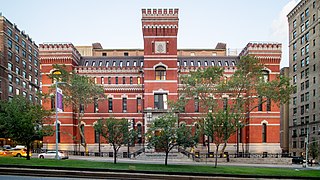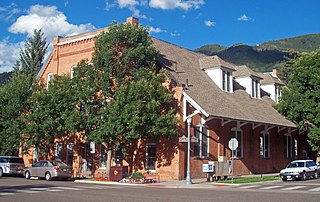
Mewata Armoury is a Canadian Forces reserve armoury in Calgary, Alberta, Canada. Mewata is a Cree word meaning "O Be Joyful".

The Seventh Regiment Armory, also known as Park Avenue Armory, is a historic National Guard armory building located at 643 Park Avenue in the Upper East Side neighborhood of Manhattan, New York City. The building is a brick and stone structure built in 1880 and designed in the Gothic Revival style by Charles Clinton.

The Colorado National Guard Armory, known commonly by locals simply as the Armory, is a landmark in Golden, Colorado. Unusual in its construction, it was at one time the largest cobblestone building in the United States. It was built in 1913 by the Colorado National Guard as an armory, quarters, mess hall and auditorium for the Guard's Company A of Engineers. When it was completed in 1914, the Company was housed in this building's second and third floors while the first-story garden level was available for rental to the public. The Armory's original uses included: Golden's Post Office ; photo shop ; barracks, mess hall, weapons storage and drill hall ; auditorium ; and map room (tower). In subsequent years the building served in part or whole as a hotel, offices, industrial bank, and student housing. During the influenza epidemic of 1918 the building became an emergency hospital for ill patients used by the Red Cross, and in 1933 it became the local headquarters of the Civil Works Administration, the federal depression era agency which created several area improvements. Calvary Episcopal Church is the current property owner.

The Kingsbridge Armory, also known as the Eighth Regiment Armory, is located on West Kingsbridge Road in the New York City borough of the Bronx. It was built in the 1910s, from a design by the firm of then-state architect Lewis Pilcher to house the New York National Guard's Eighth Coast Defense Command, a regiment-sized unit which relocated from Manhattan in 1917. It is possibly the largest armory in the world.

The Armory, historically known as the First Regiment Armory Annex, and now called Portland Center Stage at The Armory, is a historic building with two theaters inside and is located in Portland, Oregon, United States and is home to the theater company, Portland Center Stage. It was built in 1891 by Multnomah County to house the Oregon National Guard. In 2000, it was added to the National Register of Historic Places. Following a $36.1 million renovation project that lasted from 2002 to 2006, the building home to the theater company Portland Center Stage which produces 11 productions each season. An estimated 150,000 visitors visit The Armory annually to enjoy a mix of classical, contemporary and world premiere productions, along with the annual JAW: A Playwrights Festival, and a variety of high quality education and community programs.

Arvada Downtown, also known as Olde Town Arvada, is a 15.1 acres (6.1 ha) historic district in Arvada, Colorado bounded by Ralston Road, Teller Road, Grandview Avenue and Yukon Street. It was listed on the National Register of Historic Places in 1998. The listing included 42 contributing buildings.

The Centreville Armory in Centreville, Maryland, is part of a series of Maryland National Guard armories built in the 1920s in principal towns in Maryland. The armories followed a standard design with a castle-like front housing offices and meeting spaces, backed by a large drill hall.

The Medina Armory is located on Pearl Street in Medina, New York, United States. It is a large stone building constructed at the beginning of the 20th century.

The Schenectady Armory is located on Washington Avenue in the city of the same name in the U.S. state of New York. It is a brown brick building dating to 1936.

The 369th Regiment Armory is a historic National Guard Armory building located at 2366 Fifth Avenue, between West 142nd and 143rd Streets, in Harlem, Manhattan, New York City. It was built for the 369th Regiment, also known as the "Harlem Hell Fighters", founded in 1913 as the first National Guard unit in New York State composed solely of African-Americans. It later became home to the 369th Sustainment Brigade.

The Fort Washington Avenue Armory, also known as the Fort Washington Armory, The Armory, and the 22nd Regiment Armory, is a historic armory building located at 216 Fort Washington Avenue, between West 168th and 169th Streets, in the Washington Heights neighborhood of Manhattan, New York City. It is a brick Classical Revival building with Romanesque Revival elements, such as the entrance arch, and is currently home to the non-profit Armory Foundation, National Track and Field Hall of Fame, New Balance Track and Field Center, and other organizations including the Police Athletic League of New York City.

The Commandant's Quarters at the Dearborn Arsenal is a United States military structure located at 21950 Michigan Avenue in Dearborn, Michigan. Built in the early 1830s, it is the oldest building in Dearborn still located on its original site. It is considered to be one of the seven most significant buildings in Michigan. It was designated as a Michigan State Historic Site in 1956 and listed on the National Register of Historic Places in 1970.

Walton Grange No. 1454 is a historic Grange building located at 137 Stockton Avenue in Walton in Delaware County, New York, United States. Designed by architects Randall and Gilbert of Walton and built in 1886, it consists of a two-story administration building with an attached gable roofed drill shed. It was occupied from 1886-1896 by the 33rd Separate Company then vacated in 1896 and converted for use as a school and a Grange hall. It was listed on the National Register of Historic Places in 1998 as Walton Grange #1454-Former Armory.

The Gettysburg Armory is a former National Guard armory located at Gettysburg, Adams County, Pennsylvania. It was listed on the National Register of Historic Places in 1990. The 61x96 ft Art Deco facility was constructed as a $43,331 Works Projects Administration project for the local National Guard unit. The two-story building housed a garage and repair shop for military vehicles, a classroom, administrative space, and a drill hall. From the beginning, the Armory was used not only by the National Guard, but also by the local community, for sporting events and community meetings. In 1944, the Gettysburg Armory was used as a temporary German Prisoner of War camp while the official camp was being constructed on the Gettysburg Battlefield. Later the building was designated as a public fallout shelter by the National Fallout Shelter Survey.

The 23rd Regiment Armory, also known as the Bedford Atlantic Armory, the Marcy Avenue Armory, and the Williamsburg Armory, is a historic National Guard armory building located at 1322 Bedford Avenue between Atlantic Avenue and Pacific Street in the Crown Heights neighborhood of Brooklyn, New York City, United States. The building is a brick and stone castle-like structure designed to be reminiscent of medieval military structures in Europe. It was built in 1891–95 and was designed in the Romanesque Revival style by Fowler & Hough, local Brooklyn architects, and Isaac Perry, the New York state government's architect.

Aspen City Hall, known in the past as Armory Hall, Fraternal Hall, is located at the intersection of South Galena Street and East Hopkins Avenue in Aspen, Colorado, United States. It is a brick building dating to the 1890s. In 1975 it was listed on the National Register of Historic Places.

The 14th Regiment Armory, also known as the Eighth Avenue Armory and the Park Slope Armory, is a historic National Guard armory building located on Eighth Avenue between 14th and 15th Streets in the South Slope neighborhood of Brooklyn, New York City, United States. The building is a brick and stone castle-like structure, and designed to be reminiscent of medieval military structures in Europe. It was built in 1891–95 and was designed in the Late Victorian style by William A. Mundell.

Fort Homer W. Hesterly is a historic building at 522 North Howard Avenue in the West Tampa section of Tampa, Florida. The building and adjacent support structures were originally constructed as a U.S. military facility to house units of both the Florida Army National Guard and the U.S. Army Reserve. The armory was built in the 1930s under Franklin Delano Roosevelt's New Deal and dedicated the day after the Pearl Harbor attack. The National Guard used the armory until 2005.

The Duluth Armory is a former armory and event venue in the East Hillside neighborhood of Duluth, Minnesota, United States. It was built in 1915 for the National Guard and naval militia, and expanded in 1941. From the beginning the National Guard also rented out the drill hall as an event venue, as it provided a larger and more flexible space than any other local venue until the construction of the Duluth Arena-Auditorium in 1966.

The Elizabethtown Armory, at 205 Warfield St. in Elizabethtown, Kentucky, was built in 1948. It was listed on the National Register of Historic Places in 2002.






















